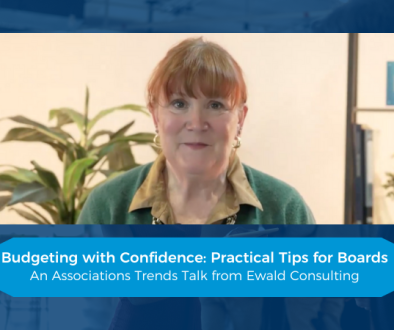Bulletproof Budgeting: How A Midyear Check on Your Association’s Budget Can Help Your Team Succeed
By Ava Ewald and Darrin Hubbard, Ewald VP of Business and Portfolio Management
This time of year, you may think, “How is it already July?” That’s right—we are already halfway through 2022. Now is not the time to let things slip. Budgets must be carefully watched year-round, but a midyear check-in may be just what you need to set up your organization for success in the second half of the year.
Budgets are made in advance without knowledge of how future events will impact decision-making. We use historical trends, adjust for location or venue changes, consider new initiatives that need funding or existing programs that need to be sunsetted, review goals for the year, and come up with a best guess for the next year. However, it is important to remember that things do not always go as you thought. It is OKAY to review the budget midyear and change course.
Preparing for your midyear budget review? Use this framework:
- Take inventory: Rudofsky Associates published a helpful piece in 2007 that still conveys great advice in 2022. There are always unexpected costs and opportunities you did not think about when the budget was originally created. You may have taken advantage of advertising opportunities you hadn’t anticipated, or maybe recognized some unexpected fees at your trade show. Rudofsky explained that by July 1, there is no hiding from the emerging results of the year. Review the first six months to get a good look at what you need to do in the next six.
- Rework: Board Effect gave advice to boards on how to build a budget. You don’t have to ditch your entire year’s budget plan—but learning how to properly work with a budget may help you make informed decisions for the rest of the year with more agility. This is why Board Effect encourages associations to view their budgets as living documents. As you review your budget, consider how attainable it is. Consider modeling three scenarios for the second half of the year:
- Base case: the base case should reflect the most likely scenario based on all the information your team knows. This is where you think you will most likely end up at the end of the year.
- Conservative: The conservative case would model the scenario where you encounter shortfalls in key areas. Are there variable expenses you can manage if there are revenue shortages? Stay in communication with your leadership to understand their expectations in this scenario. Is it acceptable to run a deficit or are expense cuts expected?
- Aggressive: If your programs perform better than you projected, what happens to the surplus? Does a new program get funded, reserve accounts replenished, or is there a policy that determines surplus usage?
- Stay in communication with your Treasurer or Finance Committee. Do your best to deal with a challenging situation by keeping the appropriate parties informed.
- Remain flexible: The National Council of Nonprofits echoed the sentiments of Board Effect in reminding readers that association budgets should never be set in stone. July is a convenient halfway point to check in, so allocate time with your board to review. If the existing budget is no longer a helpful guide, you may need to adjust your budget. While we typically do not recommend adopting a new budget midyear, some organizations will find that having a budget that more closely reflects your annual forecast can help leaders feel more informed to make decisions.
As we move into the third quarter, it can be difficult to stay optimistic after a series of world events that likely affected our budgets. However, your budget is made to help you, not restrict you. Stay on top of this critical tool and finish out the second half of the year on a high note.




